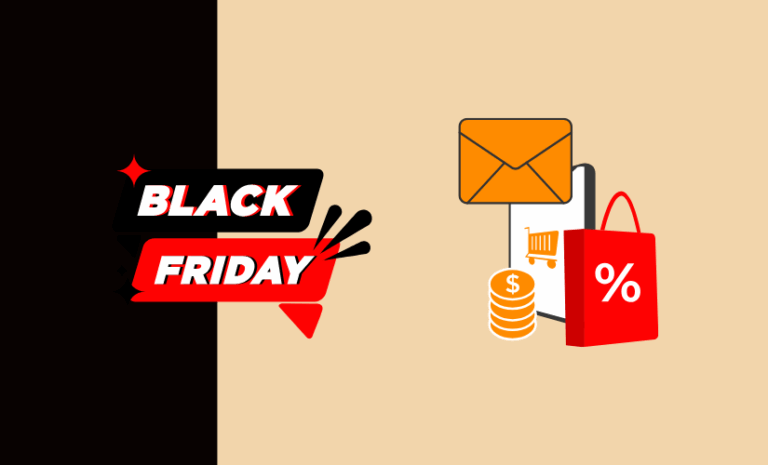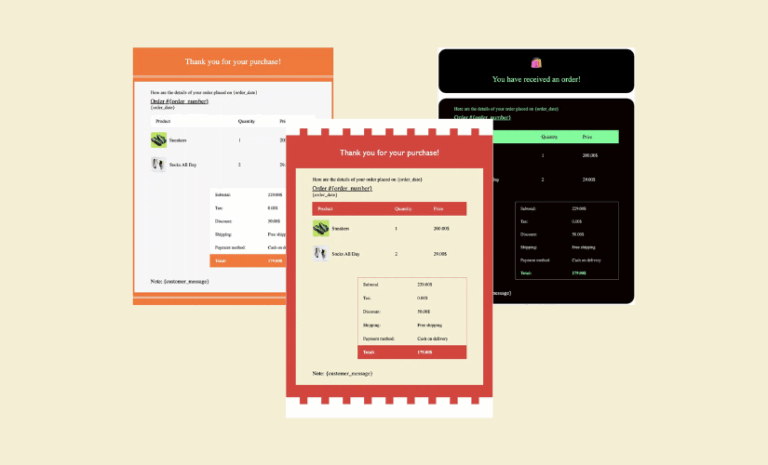Email marketing for eCommerce stores is crucial to driving sales, building relationships, and increasing brand loyalty. Email marketing can convert potential customers into repeat buyers with targeted campaigns, personalized content, and strategic automation.
Email marketing is essential for every brand. However, email marketing for eCommerce stores is particularly profitable compared to many other niches. To achieve the best results, it’s crucial to implement it correctly. Platforms like WooCommerce offer ways to segment customers based on their activities and send targeted emails.
The ability to send campaign emails and automated event-triggered emails is significantly broader for eCommerce stores built on WooCommerce.
This guide will provide a detailed overview of email marketing for eCommerce stores, including how to start and run successful email campaigns. Let’s get started.
Email Marketing for eCommerce Stores: A Complete Guide

Email marketing for eCommerce stores leverages the unique advantages of digital communication to drive sales and build customer loyalty. It involves sending targeted emails based on customer behavior, preferences, and purchase history. Key strategies include welcome series, promotional campaigns, abandoned cart reminders, and personalized recommendations.
Email marketing for eCommerce Stores involves a lot of areas. Let’s discuss the strategies in more detail.
Setting Up Your Email Marketing Strategy
Before diving into specific strategies, it’s essential to understand the foundational elements of a successful email marketing plan for eCommerce stores. This involves defining clear goals, understanding your audience, choosing the right email marketing platform, and creating a structured content calendar. These steps ensure that your email marketing efforts are organized, targeted, and aligned with your overall business objectives. With the right strategy in place, you can effectively engage your audience, drive sales, and build lasting customer relationships. Let’s explore each of these critical components in detail.
Define Your Email Marketing Goals
You need to define what this email campaign is for. Is it for awareness? Is it to boost sales? Or is it for something else? Start by setting clear, measurable goals. Whether you’re looking to increase sales, boost customer retention, or promote new products, having defined objectives will guide your strategy and help measure success. You can drive the best results when you know your goals right and work accordingly.
Understand Your Audience
Deeply understanding your audience is key. Analyze customer data to identify preferences, behaviors, and demographics. Use this information to segment your audience and tailor your messages for higher relevance and engagement. Find out what type of customers have the most buying tendencies. It could be customers coming from different regions or anything else. Knowing your audience would give you the right idea to run an effective email campaign.
Choose the Right Email Marketing Platform for Your Stores
Selecting the right email marketing platform is essential. Look for platforms that integrate seamlessly with your eCommerce system. Choose a platform that offers robust features tailored to eCommerce needs, including automation, segmentation, and analytics. Most email marketing tools focus on subscribers rather than customers. It is better to choose a solution that is built for eCommerce and focuses more on sales, customers, and orders rather than just subscribers.
Create an Email Calendar
A content calendar is crucial for planning your email campaigns. It helps ensure consistent communication and allows you to prepare for key dates like holidays, product launches, and sales events. By mapping out your campaigns in advance, you can coordinate content and promotions effectively.
Building and Segmenting Your Email List
Building and segmenting your email list involves gathering email addresses and organizing them into meaningful groups based on specific criteria such as demographics, purchase history, and behavior. This targeted approach allows you to send personalized and relevant content to each segment, increasing engagement and conversion rates. By effectively managing your email list, you ensure that your marketing efforts are focused, efficient, and capable of delivering significant returns.
Build Your Email List vs Customers list
Building your email list is crucial for eCommerce, as your customer list forms the foundation of your email marketing efforts. The beauty of email marketing for eCommerce lies in its ability to target customers repeatedly based on their actions and behavior, turning them into repeat buyers. While people may not frequently subscribe to an eCommerce store’s email list, focusing on converting customers into returning buyers is highly effective. Engaging existing customers through personalized and behavior-driven emails enhances loyalty and boosts sales.
Yet, you can have strategies to collect email leads from random website visitors. Your email list is one of your most valuable assets. Use various methods to capture email addresses, such as signup forms on your website, pop-ups offering discounts, and landing pages dedicated to email collection. Offering incentives like exclusive content or special discounts can significantly increase sign-up rates.
Segment Your Email List
Segmentation is critical for delivering personalized content. Group your email list based on demographics, purchase history, and customer behavior. This allows you to send highly targeted emails that resonate with each segment, improving engagement and conversion rates.
An eCommerce-focused email marketing solution will have built-in dynamic segments for you to target customers in campaigns. Yet, you can segment customers manually and send email campaigns for better results.
Maintain Your List
Regularly cleaning your email list is essential to maintain high deliverability and engagement rates. Remove inactive subscribers, correct invalid email addresses, and segment your list to ensure that your emails reach interested recipients. This practice helps reduce bounce rates and improves your sender reputation.
Crafting Effective Email Campaigns
Crafting effective email campaigns is crucial for engaging your audience and driving conversions. It involves creating compelling subject lines to entice opens, delivering valuable and relevant content to keep readers interested, and incorporating clear calls-to-action (CTAs) to guide them toward desired actions. Personalization is key, as tailored messages based on individual preferences and behaviors can significantly boost engagement. Additionally, ensuring a visually appealing and mobile-friendly design enhances the user experience, making your emails more effective in achieving their goals.
Compelling Subject Lines
The subject line is the first thing your subscribers see, making it crucial for grabbing their attention. Use clear, concise language and create a sense of urgency or curiosity. Personalizing subject lines with the subscriber’s name or interests can also increase open rates.
Engaging Content
The content of your emails should provide value to your subscribers. Mix product promotions with educational content, customer stories, and behind-the-scenes insights. Engaging content keeps subscribers interested and encourages them to take action.
Clear Call-to-Action (CTA)
Every email should have a clear and compelling CTA. Whether you want subscribers to make a purchase, read a blog post, or follow you on social media, make sure the CTA stands out and is easy to follow. Use action-oriented language and design elements to draw attention to your CTA.
Personal Touch
Personalization goes beyond using the subscriber’s name. Tailor your content to their preferences, past purchases, and behavior. Personalized recommendations, birthday offers, and exclusive discounts make subscribers feel valued and increase the likelihood of conversion.
Types of Campaigns in Email Marketing for eCommerce Stores
Email marketing for eCommerce stores involves various campaign types, each designed to achieve specific goals and engage customers effectively. From welcome series that introduce new subscribers to your brand, to promotional emails that announce sales and special offers, these campaigns drive conversions and foster customer loyalty. Abandoned cart emails remind shoppers of items left in their cart, encouraging completion of purchases, while transactional emails provide essential information like order confirmations and shipping updates. Re-engagement campaigns target inactive subscribers, reigniting their interest with personalized offers and content. Each campaign type plays a crucial role in a comprehensive email marketing strategy.
Welcome Series
A welcome series is your chance to make a great first impression. Introduce new subscribers to your brand with a series of welcome emails. Share your brand story, highlight bestsellers, and offer a special discount to encourage their first purchase.
Promotional Emails
Promotional emails are designed to drive sales by announcing sales, new product launches, and special offers. Use urgency and exclusivity to encourage immediate action. Highlight limited-time offers, exclusive discounts, and new arrivals to entice subscribers.
Transactional Emails
Transactional emails include order confirmations, shipping notifications, and post-purchase follow-ups. These emails are highly relevant and have high open rates. Use them to provide important information and enhance the customer experience.
If you are running an eCommerce store, it is important that your WooCommerce emails also be sent accurately, you can use Email Customizer for WooCommerce – Virfice to customize WooCommerce transaction emails and make sure your store emails represent your brand.

Abandoned Cart Emails
Abandoned cart emails remind customers of items left in their cart and encourage them to complete their purchase. Include product images, reviews, and a discount code to entice them to return and complete the transaction. Timing is critical—send the first reminder within a few hours, followed by a series of follow-up emails.
Re-engagement Emails
Re-engagement emails target inactive subscribers with special offers or personalized recommendations to re-engage them. Use creative content and enticing offers to win back their interest. Highlighting what they’ve missed and offering an exclusive discount can motivate them to re-engage with your brand.
Email Automation for eCommerce stores
Automation allows you to set up email sequences that are triggered by specific actions or events. This ensures timely and relevant communication with your customers. Automated workflows can include welcome series, post-purchase follow-ups, abandoned cart reminders, and re-engagement campaigns. Automation saves time and ensures that your customers receive the right message at the right time.
Design and User Experience
Design and user experience are crucial aspects of email marketing for eCommerce stores. A well-designed email that is visually appealing and easy to navigate enhances engagement and encourages conversions. Responsive design ensures that emails look great on all devices, while clear and intuitive layouts help subscribers easily find and act on key information. High-quality images, consistent branding, and strategically placed calls-to-action (CTAs) improve the overall user experience, making your emails more effective in capturing attention and driving sales. Prioritizing design and usability ensures your emails resonate with your audience and achieve your marketing goals.
Make Sure Your Emails Are Responsive
Ensure your emails look great on all devices by using a responsive design. A large percentage of users check emails on mobile devices, so your emails must be easy to read and navigate on smaller screens. Use a single-column layout, large fonts, and clear CTAs to enhance mobile usability.
Visual Appeal
High-quality images and a clean layout are essential for capturing your subscribers’ attention. Consistent branding, including your logo and color scheme, helps reinforce your brand identity. Use visual elements to break up text and make your emails visually appealing.
Easy Navigation
Make it easy for subscribers to navigate your email and take action. Use clear and concise CTAs, clickable images, and straightforward links. Ensure that your emails are well-organized and intuitive to enhance the user experience.
Accessibility
Ensure your emails are accessible to all subscribers, including those with disabilities. Use descriptive alt text for images, a readable font size, and sufficient color contrast. Accessibility improves the user experience and ensures that your messages reach a wider audience.
A/B Testing and Optimization
A/B testing and optimization are critical for enhancing the effectiveness of your email marketing campaigns. By testing different elements—such as subject lines, content, images, and calls-to-action—you can determine what resonates best with your audience. Analyzing the results of these tests allows you to make data-driven decisions and continuously refine your emails for better performance. This iterative process ensures that your campaigns are not only engaging but also optimized for higher open rates, click-through rates, and conversions, ultimately leading to more successful marketing efforts.
Test Elements
Conduct A/B tests on different elements of your emails, such as subject lines, content, images, and CTAs. A/B testing helps you understand what resonates best with your audience and allows you to make data-driven decisions to optimize your campaigns.
Analyze Results
Use the data from your A/B tests to make informed decisions. Analyze key metrics like open rates, click-through rates, and conversions to determine what works best. Continuously testing and refining your emails will lead to improved performance over time.
Continuous Improvement
Email marketing is an ongoing process. Regularly analyze your campaigns and make adjustments to improve performance. Stay updated with the latest trends and best practices to keep your strategy fresh and effective.
Compliance
Ensure your email marketing practices comply with regulations like the CAN-SPAM Act and GDPR. Provide a clear opt-out option and respect subscriber preferences. Transparency and respect for privacy build trust and enhance your brand reputation.
Email Deliverability
Improving your email deliverability ensures that your emails reach your subscribers’ inboxes. Maintain a clean list, avoid spammy content, and use a reputable email service provider. Monitor your sender’s reputation and address any issues promptly to maintain high deliverability rates.
Measuring Success: Analytics and KPIs for Email Marketing for eCommerce Stores
Measuring the success of your email marketing campaigns is essential for understanding their impact and optimizing future efforts. By tracking key performance indicators (KPIs) such as open rates, click-through rates, conversion rates, and unsubscribe rates, you can gauge the effectiveness of your emails. Integrating with tools like Google Analytics provides deeper insights into how email traffic contributes to website performance and sales. Regularly analyzing these metrics allows you to refine your strategies, improve engagement, and maximize the return on investment (ROI) from your email marketing efforts.
Key Metrics
Track key performance indicators (KPIs) such as open rates, click-through rates, conversion rates, and unsubscribe rates. These metrics provide insights into the effectiveness of your campaigns and help identify areas for improvement.
Customer Feedback
Collect feedback from your subscribers to understand their preferences and improve your strategy. Use surveys, feedback forms, and direct responses to gather valuable insights. Listening to your customers helps you tailor your emails to meet their needs and expectations.
Effective email marketing enhances customer engagement, increases conversion rates, and fosters long-term relationships by providing valuable content and timely offers tailored to individual customer needs. This targeted approach ensures that messages are relevant, engaging, and more likely to result in conversions.
Email marketing for eCommerce stores is different from regular email marketing campaigns. Choosing the right email marketing solution, especially one designed for eCommerce can significantly enhance the effectiveness of your campaigns. This specialized approach ensures that your campaigns are tailored to the unique needs and behaviors of eCommerce customers, leading to better results.



